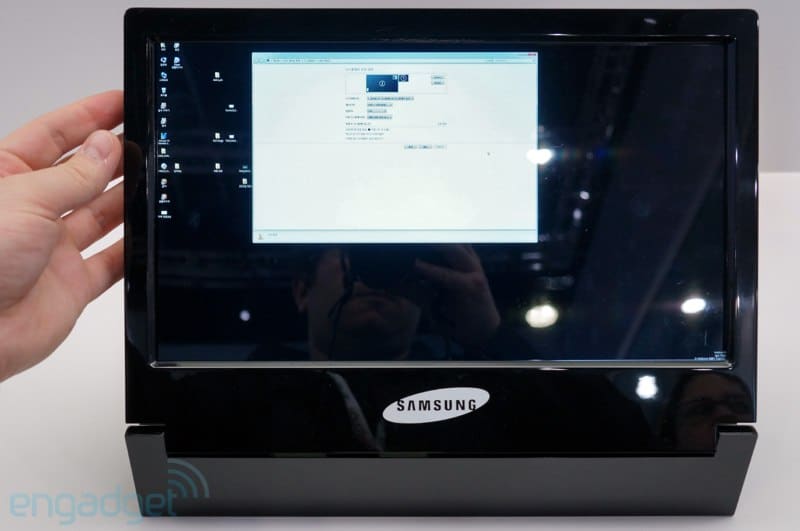Samsung will auf der Messe Display Week ein Display mit 13,3 Zoll vorstellen mit einer Auflösung von 3.200 x 1.800 Pixel. Das entspricht einer Pixeldichte von 276 ppi (Pixel per Inch). Nicht weniger beeindruckend ist ein 10,1 Zoll Display mit einer Auflösung von 2.560 x 1.600 Pixel.
Nicht einmal Apples Retina-Displays schaffen eine so hohe Pixeldichte. Die in Macbook, Iphone und Ipad verbauten Retina-Displays weisen nur eine Punktdichte von 227 ppi auf. Bei beiden Displays sind aber mit dem bloßen Auge keine Pixel zu erkennen.
Durch die Reduzierung der Treiber-Schaltkreise und die verbesserte Effizienz der Blauen-LED, verbrauchen die Displays bis zu 30 Prozent weniger Strom als herkömmliche LCD-Displays.
Nur noch wenige Pixel zum 4K-Notebook
Samsung ist auf dem besten Weg der erste Hersteller zu sein, der ein 4K-Display in voller Auflösung in ein Notebook integriert. Wenn der Hersteller aus Südkorea die Pixeldichte minimal auf 282 Pixel pro Zoll erhöhen kann, dann wäre in einem 15,6 Zoll Display bereits die volle 4K-Auflösung möglich.
In den nächsten Tagen dürfen wir mit vorzeigbaren Material von der Display Week in Vancouver rechnen. Diese findet vom 21. bis 23. Mai 2013 statt.
[fusion_builder_container hundred_percent=“yes“ overflow=“visible“][fusion_builder_row][fusion_builder_column type=“1_1″ background_position=“left top“ background_color=““ border_size=““ border_color=““ border_style=“solid“ spacing=“yes“ background_image=““ background_repeat=“no-repeat“ padding=““ margin_top=“0px“ margin_bottom=“0px“ class=““ id=““ animation_type=““ animation_speed=“0.3″ animation_direction=“left“ hide_on_mobile=“no“ center_content=“no“ min_height=“none“][fusion_title size=“2″]Update:[/fusion_title]
Samsung hat das Display nicht wie vermutet in einem Notebook oder Tablet präsentiert, vielmehr ist es ein freistehendes Display was an einem PC angeschlossen ist. Das Display ist deswegen aber nicht weniger beeindruckend. Die Pixeldichte ist wirklich erstaunlich, könnte aber auch selbst zum Problem werden, da die Symbole und Schriften auf dem kleinen Display schnell unleserlich werden.
Im unten angehängten Video kann man sich einen ersten Eindruck über das hochaufgelöste Display verschaffen.
[/fusion_builder_column][fusion_builder_column type=“1_1″ background_position=“left top“ background_color=““ border_size=““ border_color=““ border_style=“solid“ spacing=“yes“ background_image=““ background_repeat=“no-repeat“ padding=““ margin_top=“0px“ margin_bottom=“0px“ class=““ id=““ animation_type=““ animation_speed=“0.3″ animation_direction=“left“ hide_on_mobile=“no“ center_content=“no“ min_height=“none“][Expand Pressemitteilung:]
Vancouver, B. C. (CAN.) – May 20, 2013 – Samsung Display announced today that it is showcasing several industry-leading technologies and mobile to extra-large-sized display prototypes at the Society for Information Display’s Display Week 2013, May 21-23, 2013, in the Vancouver Convention Centre (Booth 700). These include a Full HD (1920×1080) mobile AMOLED display with the world’s broadest color gamut, and an 85-inch Ultra HD (3840×2160) LCD TV panel with extremely vivid color and low power consumption.
In addition, Samsung Display shows a unique new Diamond Pixel™ technology being highlighted at the show, and a featured LCD technology that enables local-dimming control in direct LED-based LCD panels.
The world’s first mass-produced 4.99-inch Full HD mobile AMOLED display offers the world’s broadest color gamut with a 94 percent average rate of reproduction for the Adobe RGB color space. The Adobe RGB standard is about 30 percent broader than general sRGB standards.
Samsung Display fulfills the most advanced mobile AMOLED display demands with its Diamond Pixel™ technology. This technology, based on the idea that the human retina reacts more to green than other colors, places more green than red and blue pixels in the pixel structure of AMOLED display panels.
With the new technology, Samsung’s Full HD AMOLED display can provide text messages 2.2 times clearer than HD (1280×720) displays. So, when curvilinear letters on the panel are magnified two or three times, Samsung’s Diamond Pixel™ technology enables text to be reproduced more smoothly (fewer „jaggies“) and accurately than those produced with conventional LCD technology.
Samsung Display is also providing Display Week participants with firsthand experience comparing the color gamut, color accuracy and letter quality of Full HD AMOLED displays in a special „experience zone“ within its booth. The booth will provide a clear comparison between AMOLED and LCD displays. Attendees can see not only true crisp colors in the intricate wing pattern of morpho butterfly images, but can also view an image of a strand of knitting wool so detailed that it can only be appreciated using a Full HD AMOLED display.
Furthermore, Samsung Display’s exhibit of an 85-inch ultra HD TV panel showcases a LCD technology that enables local-dimming control in a direct LED-based LCD panel. The panel can save 30 percent of typical LED BLU power consumption. Its local-dimming control enables vivid color rendering including incredible black images, 80 percent brightness uniformity, and a remarkably-enhanced contrast ratio.
For the latest in green technology, Samsung Display is highlighting advanced power-saving solutions for smart mobile devices including smartphones and tablets. Here, Samsung Display has innovatively reduced power consumption of AMOLED display by enhancing the luminous efficacy of AMOLED pixels. Samsung Full HD AMOLED displays provide a 25 percent power-savings over that of existing HD AMOLED displays.
Samsung Display is also exhibiting a 10.1-inch WQXGA (2560 x 1600) LCD for tablets and a 13.3-inch WQXGA+ (3200 x 1800) LCD for notebooks, which each can deliver 30 percent greater power-savings than that of existing LCD tablet displays, by decreasing the number of driver circuits and increasing the efficiency of the LED BLU.
Also, Samsung is spotlighting a 23-inch multi-touch LCD display that can detect 10 touch points simultaneously. The prototype enables playing of the piano with exceptional finesse, or drawing a highly detailed picture on a monitor or a tablet.
[/Expand]
Video:
via: engadget.com

